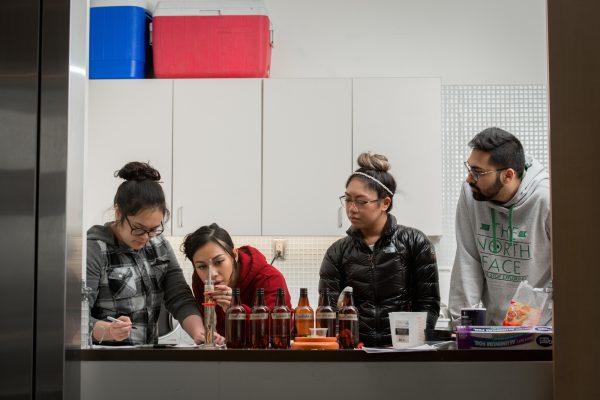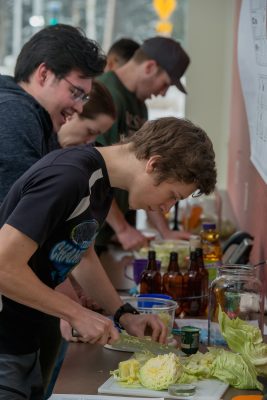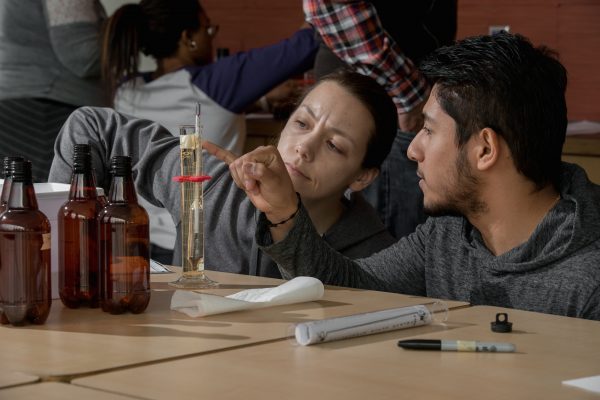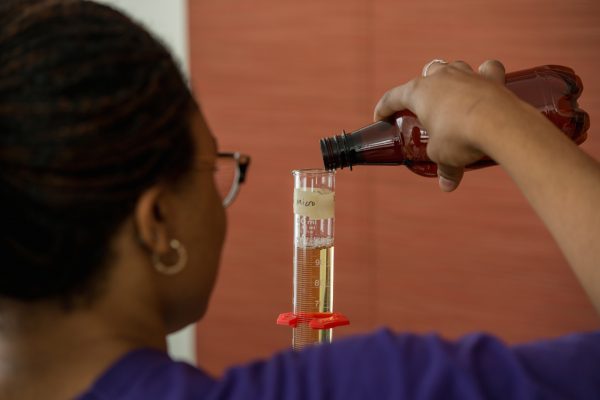Microbiologists in the kitchen
by joey |

Students in Experiential Educaiton: Microbial Biology took over a kitchen on the ground floor of the ConocoPhillips Integrated Science Building for their mid-semester food lab. (Photo by James Evans / University of Alaska Anchorage)
There are five million trillion trillion bacteria on the planet. Several thousand are probably in your refrigerator right now. Appetizing, no?
Many foods, in fact, can't exist without bacteria, as students learned in a recent microbiology lab at UAA. They prepared dishes like yogurt and sauerkraut following recipes that included bacteria and yeast among the ingredients. And yes, there was a taste test.
"[Microbiology's] not just about disease or ecology or protecting your immune system. There are food applications, too," said professor Alicia Holmgren. "We know that [bacteria] live on us and in us all the time, but they're not always seen as practical ... This is another way of exposing them to the range of what microbes do."

Students chop cabbage to add to their sauerkraut recipe. (Photo by James Evans / University of Alaska Anchorage)
The food lab is a mid-semester project in Experiential Learning: Microbial Biology. As the course name suggests, it's hands-on (or, rather, it's as hands-on as you can be with organisms a few microns in size).
In most university science courses, students follow directions from a lab manual and experiments return an expected result. Experiential learning, though, requires students to stretch beyond the book.
"They're going to have failures. They're going to see what science really is," Holmgren explained.
Amid the weekly lab assignments, students work toward a semester-length project analyzing bacteria from anywhere in the environment. Some are sampling soils at Alyeska or mud from the coast. Others are investigating the water at Goose Lake, and the bacteria removed from a rotting tomato plant. They'll analyze a specific trait of their isolated microbes, like antibiotic resistance or magnetic response.
"It's a way of experiencing what's around us and using the tools that they're learning in the lab," Holmgren said. "It's taking a lab a step forward. A lab is meant to experience science."

Jesse Johnsen and Martin Juarez-Alvarado measure samples of undiluted grape juice in their microbial biology food lab. (Photo by James Evans / University of Alaska Anchorage)
At four credits, the upper-level lab can be demanding. Microbes don't follow a typical course calendar, and students are expected to check projects regularly between classes as populations can boom or bust by the hour. "It's just the nature of microbes," Holmgren said.
That extra time commitment just plays into the experiential component of the course. "Rather than just being spoken to or reading it, you get to see it in action," she added. "Things are different every semester."
One thing that's repeatedly on the syllabus, though, is the food lab, providing an amusing break on a busy syllabus.
Midway through the course, students leave the lab and head for a kitchen of the ConocoPhillips Integrated Sciences Building, swapping Petri dishes for serving plates and thioglycolate broth for vegetable brine.
Students still follow a recipe, chopping cabbage and seasoning the sauerkraut with salt (listed, of course, as NaCl). They pour undiluted grape juice into graduated cylinders to mix various samples of wine, brewed at different dilutions.
The end result, ideally, is a presentable product. Students taste-test against store-bought equivalents while simultaneously discussing the fermentation process. Yogurt takes six to eight hours to cultivate, while the sauerkraut sampling will have to wait a month.
The experiential learning component of the course isn't lost on the students. "This has been a way to get ... hands-on with the more abstract concepts," said senior Alamin Mohammedson, who works as a certified lab tech outside of class. "It's so many things you would not do in a typical lecture or learning situation. It's a good background in microbiology. And it's fun."
"A lot of times I find lab classes tend to lag behind the lecture, but this one is almost ahead of it," said Anton Clark, a junior biology major. Instead of simply following step-by-step experiments, he said, "there's a lot more interaction, there's a lot more applications."
For his semester-long project, Clark and a classmate are isolating bacteria from rotting fruit. "We're going to be using all the procedures that we're learning from the original labs and applying it to our own completely open-ended experiment."
"It's a very rewarding experience," he said of the course. "Be ready to work, but it's super-rewarding."
Germ appétit!

(Photo by James Evans / University of Alaska Anchorage)
Written by J. Besl, UAA Office of University Advancement
 "Microbiologists in the kitchen" is licensed under a Creative Commons Attribution-NonCommercial 4.0 International License.
"Microbiologists in the kitchen" is licensed under a Creative Commons Attribution-NonCommercial 4.0 International License.














